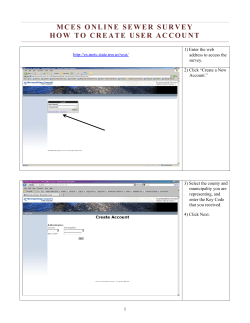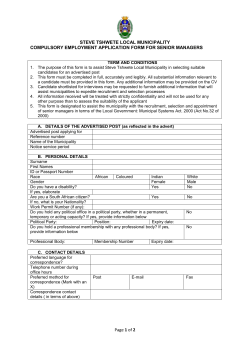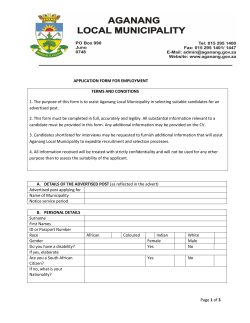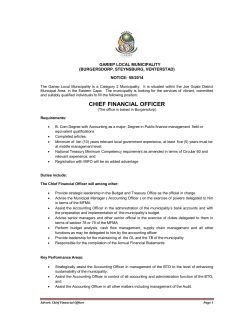
Analysing Urban Green Open Space Planning (Case - sappk
Sekolah Arsitektur, Perencanaan dan Pengembangan Kebijakan ITB Analysing Urban Green Open Space Planning (Case Study: Tangerang Municipality, Indonesia) Evan Wiraksana Maharta(1), Monika Kuffer(2), Roos Akbar(3) (1) (2) (3) Master Program in Regional and City Planning, School of Architecture, Planning and Policy Development (SAPPK), ITB. Department of Urban and Regional Planning and Geo-Information Management, ITC - University of Twente, the Netherlands. Urban Planning and Design Research Group, School of Architecture, Planning and Policy Development (SAPPK), ITB. Abstract Despite the advantages of green space for both human well-being and ecosystem, many cities struggle in providing sufficient amount of green spaces. The intertwined, hierarchical regulation and standards further complicate the planning and provision of green open space. This research analyse the urban green open space planning using remote sensing and GIS. The result shows that Tangerang Municipality has uneven distribution of green areas; and experienced green areas fragmentation and loss. Although different source of data shows different figures, they reveal that Tangerang Municipality has yet meets the national policy standard of 20% public green open space. Planning analysis reveals that the green open space master plan does not fully comply with the municipal spatial plan. Furthermore, less than 36% of planned green open space is currently green areas. These conditions may poses difficulties in implementation of the plan. Keywords: green open space, Landsat, NDVI, planning analysis, remote sensing Introduction Despite the advantages of green open space for ecosystem (James et al., 2009; Riswan, Putra, and Jannah, 2005; Xu et al., 2011), urban environment (Bernatzky, 1982; Georgi and Dimitriou, 2010), health (Fan, Das, and Chen, 2011; Khotdee, Singhirunnusorn, and Sahachaisaeree, 2012) and well-being of urban residents (Khotdee et al., 2012; Peschardt and Stigsdotter, 2013), many cities struggle in providing sufficient amount of green spaces. Urban green spaces are limited resource, and has been reduced and become more fragmented (Baycan-Levent and Nijkamp, 2009) due to land use change, economic growth, population increase, urbanization, and weakness in planning and managing the urban development (Uy and Nakagoshi, 2007). The problem for maintaining and developing green open space can be caused by: lack of coordination between agencies involved (Purnomohadi, 1994), conflicting interests, no integrated city planning, natural resources destruction, and weakness in public society participation (Riswan et al., 2005). Different agencies or departments can have different responsibilities regarding green open space provision. The division of statutory powers and ineffective communication amongst departments can be major cause of stationary management of green open space. The complexity of green space management by public sector (Riswan et al., 2005), thus, can lower the implementation of green open space plan. The weakness of green open space planning is enforced by the spread of responsibilities among variety of departments and severe constraints of skills and resources (Baycan-Levent and Nijkamp, 2009). In Tangerang Municipality, the responsibilities of developing the spatial plan and the green open space master plan lie in two Jurnal Perencanaan Wilayah dan Kota B SAPPK V4N1 | 105 Analysing Urban Green Open Space Planning (Case Study: Tangerang Municipality, Indonesia) different agencies. City Planning Agency has the responsibility to create the municipal spatial plan, whereas the City Cleaning and Landscaping Agency is in charge for creating the green open space master plan. Those differences between agencies will result in the poor realization in green open space provision. Green open space provision, by law, need to be planned, acquired, built and managed properly; and hence accurate data is required. Remote sensing (RS) can be an appropriate tool to analyse discrepancies between the current and future plans of public green open space. Vegetation indices, such as Normalized Difference Vegetation Index (NDVI) can depict the location of green areas and their size as base data for planning and management purposes. Furthermore, when combined with appropriate Geographic Information System (GIS) tools, remote sensing can also be helpful to determine the fitness of green open space plans, for example compared to existing green areas. images with less than 10% cloud coverage within the time span from 1994 to 2013. To prevent variations in NDVI values derived from remote sensing imagery (Abuzar et al., 2014), only images from two sensors were used although there were two usable Landsat 7 ETM in 1999-2000. Green Areas Analysis Green area in the study area was obtained using the NDVI analysis. Radiometric calibrations to convert DN value into top-of atmosphere reflectance were conducted beforehand using data from metadata of the remote sensing data. The Normalized Difference Vegetation Index (NDVI) is used to transform multispectral remote sensing data into single band image representing vegetation distribution. The single band NDVI images were then re-classified into binary map using an arbitrary threshold. The reclassification and accuracy assessment steps were conducted in several iterations until the highest accuracy value was achieved for each NDVI image. Datasets Classification accuracy assessment is systematically compare pixels or polygons in a remote sensing derived classification map with the ground reference test information (Jensen, 2005). Since there were limitations in time and resources, ground reference information was derived using Google Earth’s time shift feature. Table 1 shows the datasets acquired and used in this research. The Landsat images used in this research were selected from the archive of Kappa analysis is used to assess accuracy in remote sensing classification analysis. Kappa analysis yields K hat statistic which is estimate of The general aim of this study is to analyse the conditions and the planning of public green open space using remote sensing and GIS. Method Table 1. Datasets obtained and used in this research No 1 2 3 4 5 6 Data Land cover map Municipal spatial plan Green open space inventory Green open space list Green open space master plan Tangerang municipality in figures Source City Planning Agency City Planning Agency City Cleaning and Landscaping Agency City Cleaning and Landscaping Agency City Cleaning and Landscaping Agency Central Statistical Bureau 7 Landsat images USGS 106 | Jurnal Perencanaan Wilayah dan Kota B SAPPK V4N1 Year 2012, 2013 2012 2008 2012 2012 2009, 2011, 2013 Sept. 1994, Aug. 1999, July 2006, July 2013 Evan Wiraksana Maharta Kappa (Jensen, 2005). It is measure of agreement or accuracy between the remote sensing derived classification map and the reference data. The last landscape calculated using the as input. step in green areas analysis is metrics calculation. The FRAGSTATS the landscape metrics of green areas resulted binary maps of green areas Urban Green Open Space Analysis The (public) green open space maps were derived from the municipal data. City Cleaning and Landscaping Agency provided green open space data whereas City Planning Agency supplied land use/land cover data. The data received from the municipality need first to be checked for errors, inconsistencies or redundancies caused by different processing extent and data lineage. The next step is topology check and fix for all the spatial data against ‘must not overlap’ rules. The green open space data then were converted into raster format to be analysed in FRAGSTATS for landscape metrics. Landscape Metrics and Fragmentation Analysis The computation of landscape metrics of categorical maps were conducted using FRAGSTATS. In this study, two levels of heterogeneity were analysed: class level metrics and landscape level metrics. Landscape level metrics were assessed for green open space data only. Urban Green Open Space Analysis The (public) green open space maps were derived from the municipal data. City Cleaning and Landscaping Agency provided green open space data whereas City Planning Agency supplied land use/land cover data. Urban Green Open Space Planning Analysis Several overlays or comparison were conducted to analyse the planning of green open space. Accuracy or discrepancy of categorical data from municipality with the data derived from remote sensing can also be examined by superimposing those maps and examine any differences. Results and Findings Green Areas The green areas map of Tangerang Municipality is derived from Landsat images using NDVI calculation. In the NDVI binary classification, a dynamic threshold is used to determine where the green areas in the Tangerang Municipality are. Several iterations were carried out to find a threshold that gave the highest accuracy. Table 2. Threshold, accuracy and Kappa values Image 22 Sept. 1994 19 Aug. 1999 5 July 2006 8 July 2013 Threshold 0.124 0.305 0.2235 0.248 Accuracy 84.14% 86.90% 90.34% 89.66% Kappa 0.6571 0.7380 0.8051 0.7801 The different threshold value is caused by variation in the NDVI value of those four images. According to Jensen (2005), the reflectance of near-infrared that form NDVI value can also provide information about plant health, senescence and stress. The seasonal change and haze in the atmosphere can also cause the variations. Although adequate image calibration to achieve compatible top of atmosphere reflectance have been conducted, atmospheric conditions i.e. water vapour can affect the NDVI calculation result. El Nino/La Nina phenomena (also called El Nino/Southern Oscillation or ENSO) can be a major reason for climatic anomalies in equatorial region such as Indonesia. According to data of Multivariate ENSO Index (MEI) from NOAA, Indonesia experienced the higher precipitation than usual due to the “strong” La Nina effect in the period of year 1999-2000, 2007-2008 and 2011. The NDVI anomalies can be associated with ENSO indices (Erasmi et al., 2009). The difference in precipitation will further generate deviation in NDVI value due to both the plants vigour and the atmospheric haze. Jurnal Perencanaan Wilayah dan Kota B SAPPK V4N1 | 107 Analysing Urban Green Open Space Planning (Case Study: Tangerang Municipality, Indonesia) (a) (b) (c) (d) Figure 1. Green areas results from NDVI analysis on Landsat images dated (a) 22 September 1994, (b) 19 August 1999, (c) 5 July 2006, and (d) 8 July 2013. Generally, several inferences can be drawn from the green areas maps in Figure 1 i.e. there are changes in the amount, distribution, and fragmentation in Tangerang Municipality in the period from 1994 to 2013; and inequality of green areas across the municipality. Tangerang Municipality experienced massive amount of green areas loss (i.e. 4,546 ha) in 20 years period from 1994 to 2013. The green areas declined especially in the North West (Neglasari, Benda, and Batuceper) and South East (Larangan, Cipondoh and Karang Tengah) of Tangerang Municipality. Spatial metrics can be used to explain the fragmentation in the green areas. The 108 | Jurnal Perencanaan Wilayah dan Kota B SAPPK V4N1 decreasing value of the total class area (CA) over time when the number of patches (NP) increases suggest that the green areas become more fragmented (i.e. patches are smaller and more dispersed). Furthermore, the decreasing value of percentage of like adjacencies (PLADJ) and aggregation index (AI) confirm the fragmentation trend. Table 3. Class-level spatial metrics of green areas Year 1994 1999 2006 2013 CA 13614 9974 8981 9054 NP 655 1118 1459 1483 PLADJ 91.88 84.80 83.88 82.82 AI 92.12 85.07 84.15 83.08 Evan Wiraksana Maharta (a) (b) (c) (d) Figure 2. Green open space: (a) according to LULC 2012 from DTK, (b) according to LULC 2013 from DTK, (c) according to study conducted by DKP, and (d) loss in 2012 to 2013 according to LULC 2012-2013. Urban Green Open Space Central Statistical Bureau of Indonesia (2011) reported that between 2010 and 2009, the green areas in Tangerang Municipality decreased by 35 hectares. Calculation using green areas derived from remote sensing data also concurs with the decreasing trend of green open space. The public green open spaces in Tangerang Municipality are currently managed by the City Cleaning and Landscaping Agency. According to the agency’s report (2012), Tangerang Municipality has 2,124.52 ha (12.60%) green open space comprises 1,861.67 ha (11.04%) public and 262.85 ha (1.56%) private green open space. From that amount, only 47.54 ha is currently managed and maintained by the agency. The green open space map can be derived from two sources: land use and land cover (LULC) update data provided by City Planning Agency (DTK) and a result of green open space study conducted by City Cleaning and Landscaping Agency (DKP). Their classification, accuracy and data consistency, however, differ due to difference in point of view regarding green open space. City Planning Agency classifies the green open space among other land use and land cover classes. City Cleaning and Landscaping Agency, however, further divide (and reclassifies) the green open space into three classes. Since DTK provided two years of LULC data, the trend of green open space can also be examined. Green open space in Tangerang Jurnal Perencanaan Wilayah dan Kota B SAPPK V4N1 | 109 Analysing Urban Green Open Space Planning (Case Study: Tangerang Municipality, Indonesia) Municipality has decreased by 137.83 ha from 4,865.91 ha in 2012 to 4,728.08 ha in 2013. Due to discrepancies in the classification employed, it is inevitable that the green open space data also differs in both spatial extent and amount. Difference in classification can also be observed from the spatial metrics calculation. Total area, number of patches and patch density differs significantly, while contiguity index only show slight difference. Table 4. Class-level spatial metrics of green open space, based on two source of data Data LULC 2013 DKP 2013 CA NP PD CONTIG 4734 23485 129.14 0.1765 2476 10223 56.22 0.1757 Green Open Space Planning The Ministry of Public Works regulation (2008) stipulated the hierarchy and catchment area as standard in planning green open space, as well as green open space requirements per capita. Taken into account the total and distribution of population by district in 2012, the green open space that should be provided by Tangerang Municipality is 1,209 ha. The study conducted by City Cleaning and Landscaping Agency (2012), however, lists the requirement of green open spaces which are 1,510.2 ha for public and 1,423.1 ha for private green open space. Apart from discrepancies in classification and standards employed, the planning products related to the urban green open space also differs significantly. Although it is understandable due to different regulations that should be followed by the two plans, both plan should actually agree with each other. However, only 60.32 ha of planned green open space in the master plan were also designated as green open space in the municipal spatial plan. The green open space master plan was also compared to the current green areas to examine whether the plan takes into account the current distribution of green areas and to estimates the 110 | Jurnal Perencanaan Wilayah dan Kota B SAPPK V4N1 land that need to be acquired. From 19.6 km2 planned green open space, only less than 7 km2 is currently green areas, while the other 12.6 km2 is mostly built-up area. Discussion This study demonstrates the use of freely available remote sensing data as tool to derive information about green open space in urban environment. Archive of multi spectral Landsat imagery can provide a time-related urban vegetation analysis. Google Earth can be useful in both acquire information on urban green open space and checking or validating the classification result. Those opportunities however also come with several limitations. Vegetation indices derived from remote sensing imagery can only provide information about the vegetation. Other on-site information or expert knowledge is required if the green open space data is needed. In the tropical areas, especially in areas that are greatly influence by atmospheric (and oceanic) variation such as Indonesia, obtaining and deriving information from remote sensing data can be perplexing. Obtaining remote sensing image that is free from clouds and haze is also challenging. This research also reveals that municipal data reliability is somewhat low. At least two reasons can cause it. Firstly, the metadata about data lineage and previous processing is not maintained. Secondly, the different knowledge, experience and viewpoints of agency’s employee responsible for data management differ greatly. The less-reliable municipal data can pose several problems. First, the accuracy of the final product is greatly influenced. Second, it will limit the planning collaboration and information sharing. Conclusion According to the data extracted from the remote sensing, Tangerang Municipality has 9,022 ha (48.97%) green areas which are unevenly distributed across districts. Tangerang Evan Wiraksana Maharta Municipality experienced a large amount of green areas loss (4,546 ha) in 20 years period from 1994 to 2013. The green areas also became more fragmented. The remote sensing data can be useful to extract information about green areas in a cost effective and timely manner. However, the use of remote sensing in a heterogenic urban setting is limited by the spatial resolution, spectral characteristic and radiometric. It also depends on which vegetation index is used. This research shows that large variation in both plant and atmospheric condition may also limit the applicability of remote sensing. Three sources of green open space show different number of green open space in Tangerang Municipality. An estimate by City Cleaning and Landscaping Agency shows 2,124 ha (12.60%) green open space (1,861 ha 10.10% public). According to map of green open space obtained from the same agency, however, the amount is significantly lower: only 1,313 ha or 7.13% (1,196 ha or 6.49% public). City Planning Agency however show a larger value (4,728 ha or 25.66%) of green open space. Municipal data also show the distribution, fragmentation and loss of green open space. Green open space has decreased 137 ha from 2012 to 2013. It is evident that according to the municipal data, Tangerang Municipality has yet meet the national policy requirement. According to the plan analysis, however, the green open space plan and spatial plan do not comply with each other. Only 3% of planned green open space in master plan is also classified as planned green open space in the spatial plan. When compared to green areas derived from the remote sensing, only less than 700 ha or 35.29% of planned green open space is currently green areas. The rest is located in the built-up area. Acknowledgments I would like to express my gratitude to my supervisors, Monika Kuffer, M.Sc. from ITC, the Netherlands and Prof. Roos Akbar from ITB for their invaluable assistance, support and guidance. References Abuzar, M., K. Sheffield, O. Whitfield, M. O’Connell and A. McAllister. (2014). Comparing inter-sensor NDVI for the analysis of horticulture crops in south-eastern Australia. American Journal of Remote Sensing, 2(1), 1– 9. Baycan-Levent, T. and P. Nijkamp. (2009). Planning and management of urban green spaces in Europe: comparative analysis. Journal of Urban Planning and Development, 135(1), 1–12. Bernatzky, A. (1982). The contribution of tress and green spaces to a town climate. Energy and Buildings, 5(1), 1–10. Erasmi, S., P. Propastin, M. Kappasand O. Panferov. (2009). Spatial patterns of NDVI variation over Indonesia and their relationship to ENSO warm events during the Period 1982– 2006. Journal of Climate, 22(24), 6612–6623. Fan, Y., K.V.Das and Q. Chen. (2011). Neighborhood green, social support, physical activity, and stress: assessing the cumulative impact. Health Place, 17(6), 1202–1211. Georgi, J. N. and D. Dimitriou. (2010). The contribution of urban green spaces to the improvement of environment in cities: case study of Chania, Greece. Building and Environment, 45(6), 1401–1414. James, P., K. Tzoulas, M.D. Adams, A. Barber, J. Box, J. Breuste, … C. Ward Thompson. (2009). Towards an integrated understanding of green space in the European built environment. Urban Forestry & Urban Greening, 8(2), 65– 75. Jensen, J. R. (2005). Introductory Digital Image Processing: A Remote Sensing Perspective (3rd. ed., p. 526). Upper Saddler River, NJ: Pearson Prentice-Hall. Khotdee, M., W. Singhirunnusorn, W. and N. Sahachaisaeree. (2012). Effects of green open space on social health and behaviour of urban residents: a case study of communities in Bangkok. Procedia - Social and Behavioral Sciences, 36 (June 2011), 449–455. Jurnal Perencanaan Wilayah dan Kota B SAPPK V4N1 | 111 Analysing Urban Green Open Space Planning (Case Study: Tangerang Municipality, Indonesia) Peschardt, K. K., and U.K. Stigsdotter. (2013). Associations between park characteristics and perceived restorativeness of small public urban green spaces. Landscape and Urban Planning, 112, 26–39. Purnomohadi, N. (1994). Green open space to improve air quality in metropolitan Jakarta. Ekistics, 61(364-365), 47–58. Riswan, S., T.K. Putra and N. Jannah. (2005). Jakarta green open areas and its challenges. Journal of International Development and 112 | Jurnal Perencanaan Wilayah dan Kota B SAPPK V4N1 Cooperation, 11(2), 111–122. Retrieved from http://ir.lib.hiroshima-u.ac.jp/00029764 Uy, P. D. and N. Nakagoshi. (2007). Analyzing urban green space pattern and eco-network in Hanoi, Vietnam. Landscape and Ecological Engineering, 3(2), 143–157.
© Copyright 2025









